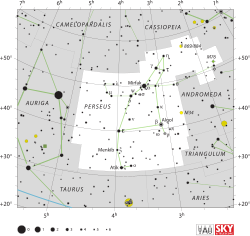
Back Adid Australis AST Èpsilon de Perseu Catalan Épsilon Persei Spanish اپسیلون برساووش Persian Epsilon Persei Finnish Epsilon Persei French אפסילון בפרסאוס HE Epsilon Persei ID Epsilon Persei Italian ペルセウス座イプシロン星 Japanese
| Observation data Epoch J2000 Equinox J2000 | |
|---|---|
| Constellation | Perseus |
| Right ascension | 03h 57m 51.23205s[1] |
| Declination | +40° 00′ 36.7752″[1] |
| Apparent magnitude (V) | +2.88[2] |
| Characteristics | |
| Spectral type | B0.5III[3] |
| U−B color index | −0.96[2] |
| B−V color index | −0.20[2] |
| Variable type | β Cep[4] |
| Astrometry | |
| Proper motion (μ) | RA: +14.06[1] mas/yr Dec.: −23.78[1] mas/yr |
| Parallax (π) | 5.11 ± 0.23 mas[1] |
| Distance | 640 ± 30 ly (196 ± 9 pc) |
| Orbit[5] | |
| Primary | Primary |
| Companion | Secondary |
| Period (P) | 14.06916±0.00004 d |
| Eccentricity (e) | 0.5549±0.0093 |
| Periastron epoch (T) | 47767.543±0.024 |
| Argument of periastron (ω) (secondary) | 105.8±1.2° |
| Semi-amplitude (K1) (primary) | 15.23±0.20 km/s |
| Orbit[5] | |
| Primary | Primary/secondary |
| Companion | Tertiary |
| Period (P) | 26.22 yr |
| Eccentricity (e) | 0.474±0.027 |
| Periastron epoch (T) | 35632±116 |
| Argument of periastron (ω) (secondary) | 170.4±3.3° |
| Semi-amplitude (K1) (primary) | 10.84±0.62 km/s |
| Details | |
| Primary | |
| Mass | 13.5±2.0[5] M☉ |
| Radius | 7.66[6] R☉ |
| Luminosity | 28,330[7] L☉ |
| Temperature | 26,500[7] K |
| Rotational velocity (v sin i) | 155±20[6] km/s |
| Age | 15.4±0.6[8] Myr |
| Secondary | |
| Mass | 0.85–1.77[5] M☉ |
| Radius | 1.4±0.4[5] R☉ |
| Rotational velocity (v sin i) | 300±30[6] km/s |
| Tertiary | |
| Mass | 2.3[9] M☉ |
| Other designations | |
| Database references | |
| SIMBAD | data |
Epsilon Persei, Latinized from ε Persei, is a multiple star system in the northern constellation of Perseus. It has a combined apparent visual magnitude of +2.88,[2] which is bright enough to be viewed with the naked eye. Based upon parallax measurements, this system is located at a distance of roughly 640 light-years (196 parsecs) from Earth.[1]
This is a spectroscopic binary system, which means that the presence of an orbiting companion has been revealed by radial velocity variations in the spectrum of the primary. The two components are orbiting each other with a period of 14 days at a high orbital eccentricity of 0.55. The secondary component has about 6–13% of the primary's mass and may have a stellar classification in the range from A6 V to K1 V. There may be a third component to this system with an orbital period of roughly 9,428 days (25.8 years), although this has not been conclusively demonstrated. If this component exists, it would have about 51–139% of the primary's mass. This high level of uncertainty is because the inclination of the orbit is not known.[5]

The primary component of this system is a massive star with 12–16[5] times the Sun's mass and near eight times the radius of the Sun.[6] It was chosen as an MK spectral standard for the class B0.5III,[3] making it a giant star that has evolved away from the main sequence. It has also been classified as a main sequence star, reflecting its evolutionary state near or slightly beyind the end of core hydrogen fusion.[6] Component A is radiating over 28,000[7] times the Sun's luminosity from its outer envelope at an effective temperature of 26,500 K.[7] This gives the star the blue-white hue that is typical of B-type stars.[12] It is also a Beta Cephei variable star with a primary pulsation period of 0.1603 days, or 6.24 cycles per day. It may have multiple pulsation frequencies.[4]
Epsilon Persei has several resolved companions listed in multiple star catalogues: component B is a 9th-magnitude A2 main sequence star 9″ away and considered to be a common proper motion companion although they are too far apart for any orbital motion to be observed; component C is a 14th-magnitude background star about 80″ away; and HD 275984 163″ away is thought to be another common-proper-motion companion.[13][9]
- ^ a b c d e f Cite error: The named reference
aaa474_2_653was invoked but never defined (see the help page). - ^ a b c d Cite error: The named reference
aj82_431was invoked but never defined (see the help page). - ^ a b Cite error: The named reference
MK78was invoked but never defined (see the help page). - ^ a b Cite error: The named reference
apjss158_2_193was invoked but never defined (see the help page). - ^ a b c d e f g Cite error: The named reference
aaa446_2_583was invoked but never defined (see the help page). - ^ a b c d e Cite error: The named reference
mnras392_1_448was invoked but never defined (see the help page). - ^ a b c d Cite error: The named reference
an331_4_349was invoked but never defined (see the help page). - ^ Cite error: The named reference
mnras410_1_190was invoked but never defined (see the help page). - ^ a b Cite error: The named reference
mscwas invoked but never defined (see the help page). - ^ Cite error: The named reference
SIMBADwas invoked but never defined (see the help page). - ^ Cite error: The named reference
HIPCurvewas invoked but never defined (see the help page). - ^ Cite error: The named reference
csirowas invoked but never defined (see the help page). - ^ Cite error: The named reference
wdswas invoked but never defined (see the help page).
